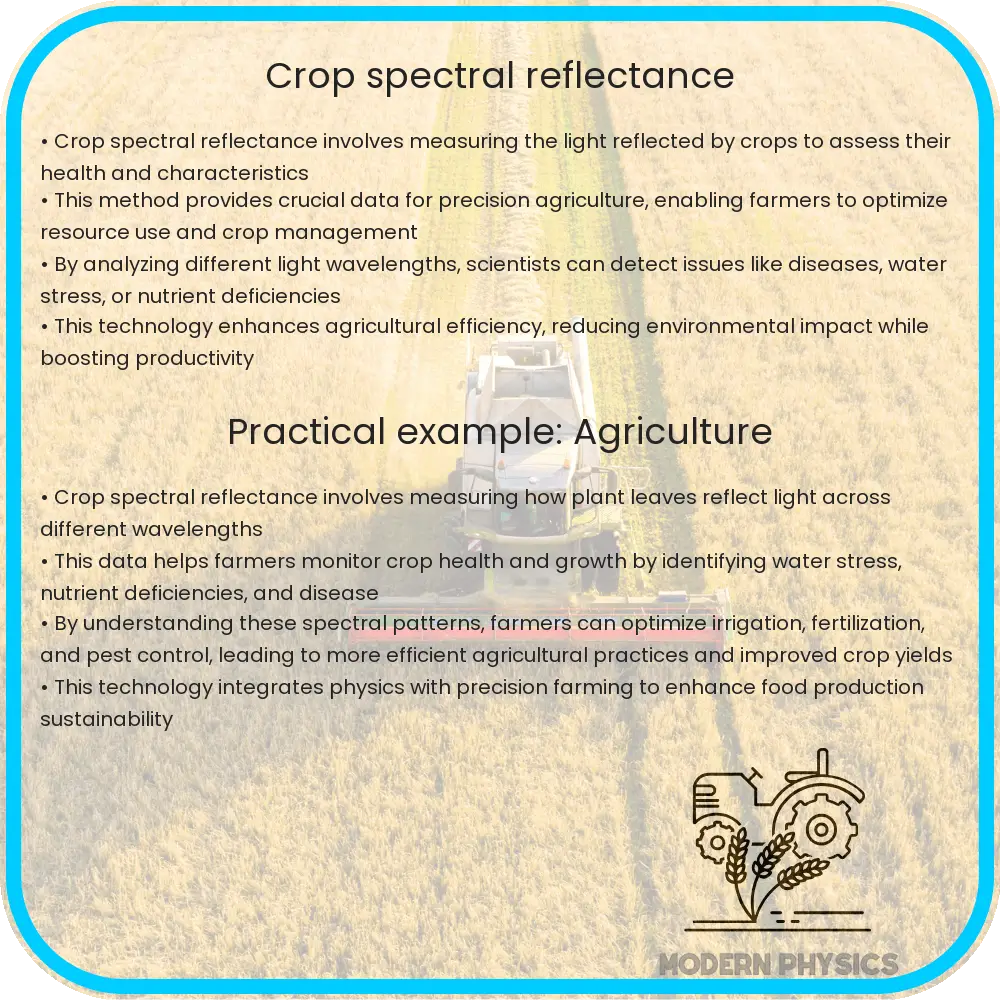Understanding the use of crop spectral reflectance in precision farming for enhancing crop health and productivity.

Understanding Crop Spectral Reflectance in Precision Farming
Modern agriculture relies heavily on technology to increase efficiency and productivity. One of the innovative technologies shaping the future of farming is the use of crop spectral reflectance in precision farming, yield analysis, and crop health monitoring. This technology utilizes the principles of light reflection from crop surfaces to provide vital information about crop health and productivity.
What is Crop Spectral Reflectance?
Crop spectral reflectance is the measurement of light that is reflected off the surface of crop plants. Different wavelengths of light are absorbed, transmitted, or reflected by the plants based on their current health and physiological status. Typically, healthy vegetation absorbs most of the visible light (particularly the blue and red wavelengths) and reflects a larger portion of the near-infrared light.
This distinctive pattern of absorption and reflection is primarily due to the presence of chlorophyll, a key pigment in plants responsible for photosynthesis, and the structure of the plant’s cells and tissues. By measuring how different wavelengths of light are reflected by crops, farmers can infer a wealth of information about the plants’ health and vigor.
Application in Precision Farming
Precision farming is an agricultural approach aimed at enhancing crop production efficiency by tailoring farming practices to varying conditions within a field. Spectral reflectance data is ideally suited for this as it provides detailed insights about the spatial variability of crop health across a farm. These data can be collected using sensors mounted on satellites, drones, aircraft, or ground-based equipment. Once the data are captured, advanced algorithms interpret the spectral images to extract meaningful information that can guide farm management decisions.
- Soil Health Assessment: Variation in spectral reflectance can indicate different soil conditions such as moisture content and nutrient levels, allowing for precise soil management.
- Disease and Pest Detection: Changes in the reflection patterns can signal the outbreak of diseases or pest infestations, often before the problems are visible to the naked eye.
- Water Stress Analysis: Reflectance data can also reveal water stress in crops, enabling timely irrigation adjustments.
Boosting Yield Analysis through Spectral Data
Yield analysis benefitted considerably from the advancements in spectral technology. By analyzing crop reflectance data throughout the season, farmers can identify which areas of a field are likely to produce higher or lower yields. This information is crucial for optimizing inputs like fertilizers and pesticides to match the specific needs of different crop zones, thus maximizing overall yield while conserving resources.
Advanced spectral imaging can also predict yield by quantifying the biomass and estimating the rate of photosynthesis in crop plants. These estimates allow farmers to make informed decisions to enhance crop production strategically.
Crop Health Monitoring with Spectral Reflectance
Regular monitoring of crop health using spectral reflectance can drastically reduce the risks associated with farming. Since this method provides non-destructive analysis, it allows for continuous health monitoring without harming the crops. This ongoing monitoring can be pivotal in timely interventions that prevent yield losses.
For instance, spectral reflectance can detect nutrient deficiencies. Certain nutrients influence specific wavelengths of light, and their deficiency alters the normal spectral signature of the crop. By recognizing these changes early, farmers can correct the deficiencies before they impact the crop adversely.
Moreover, the technology enables the tracking of the growth progress and development stages of the crop, ensuring that crops are harvested at their peak quality and maturity.
The potential applications of crop spectral reflectance are immense, transforming how we understand and manage agricultural production. In the next section, we will delve deeper into the technical workings of spectral sensors and explore case studies highlighting the success of this technology in modern agricultural practices.
Technical Workings of Spectral Sensors
Spectral sensors are at the core of measuring crop spectral reflectance. These sensors operate by detecting the light wavelengths reflected from crop surfaces. Each sensor is designed to capture specific bands of the electromagnetic spectrum, ranging from visible light to near-infrared or even further. The sensors are typically mounted on various platforms, like satellites, drones, or handheld devices, allowing them to gather data over large areas or focus on specific plant details.
The data collected by these sensors are processed using specialized software that interprets the light signatures into usable information. This process involves correcting for atmospheric interference, sensor noise, and other potential distortions to ensure the accuracy of the reflectance data.
Case Studies in Agricultural Success
To better understand the impact of spectral reflectance technology, let’s consider some real-world examples:
- In California, grape vineyards utilize spectral sensors on drones to monitor plant health and optimize irrigation schedules. This practice has led to a significant reduction in water use while maintaining the quality of the grapes.
- In the Midwest, a wheat farming operation employed satellite-based spectral imaging to detect fungal infections early. The timely detection allowed them to treat the affected areas selectively, reducing fungicide use and minimizing crop damage.
These examples highlight the significant advantages that spectral reflectance technology offers to modern agriculture, making it a crucial tool for sustainable farming practices.
Conclusion
The advent of crop spectral reflectance in precision farming opens a myriad of possibilities for boosting efficiency, crop yield, and sustainable management in agriculture. By leveraging the power of light reflection and advanced sensor technology, farmers can gain unprecedented insights into crop health and environmental conditions. This technology not only optimizes resource usage but also enhances the decision-making process, leading to healthier crops and more predictable yields.
As we move forward, the integration of more advanced computational models and increasingly sensitive sensors promises to push the boundaries of what can be achieved. This ongoing evolution will invariably support the world’s agricultural sectors in meeting the increasing demands for food production in an environmentally friendly and cost-effective manner.
Understanding and implementing crop spectral reflectance is therefore not just about agricultural efficiency — it’s also a step towards a more sustainable and secure global food system.
